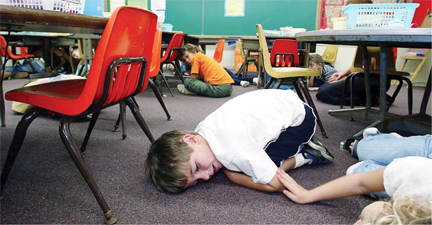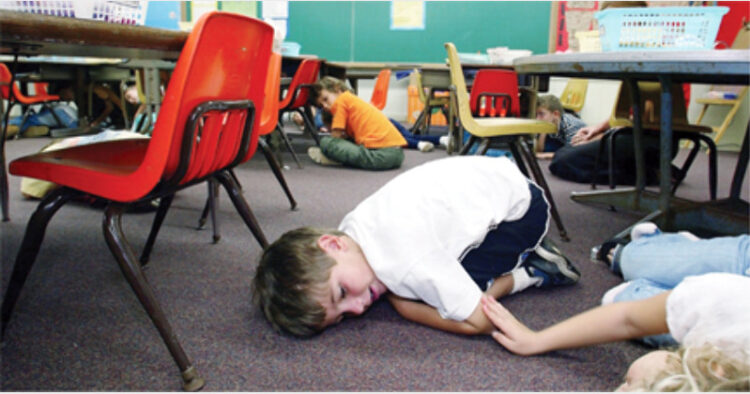 The US is in a serious crisis following a spate of shoot-out incidents in schools killing scores of children. As the gun culture penetrates classrooms, alarming bells are ringing aloud
The US is in a serious crisis following a spate of shoot-out incidents in schools killing scores of children. As the gun culture penetrates classrooms, alarming bells are ringing aloud
Ajay Bhardwaj
A 15-year-old boy opened fire with a handgun at the start of the school at Kentucky High School, killing two students and wounding scores of others. In another incident, a teenager was wounded by a shot fired in her school cafeteria in Texas.
The same day a bullet grazed a 14-year-old boy in the parking lot of a New Orleans high school. School compounds have become new bullet grounds in the US.
The Gun culture, that the US has so assiduously built over the last many decades to shape itself as a superpower, has started causing problems at its backyards. The country, which prospered limitlessly by promoting the sale of arms and ammunition all over the globe, and sometimes plotted warlike situations elsewhere to please the gun lobby back home, is now feeling the heat of it all within. Not because of criminals or mafias in the country. The cry has come from tender school-going children who have been queerly falling victim to a new shock-wave triggered by guns and bullets on their school compounds. Children do not know who, from among them, would get a gun tomorrow and mow them down.
It is a weird culture in the US where there are no restrictions on keeping a gun. Sometimes, you can even buy one over the Walmart counters as well. While in states like Vermont children as young as 16 years can buy a gun without parental consent, for possessing a long gun there is just no minimum age limit. While for buying a handgun one needs to register with the police, for long guns there is no such requirement either.
Though the gun-keeping laws have been too liberal, what has been driving young children to wield weapons and gun down their school mates? Could it be a psychological crisis of a child or just that he is misdirecting his rage with guns freely available around?
In 2018 in the last three months, 19 incidents of shoot-outs in schools have taken place sending shock waves across the country.
The nation, however, woke up to the gravity of the problem when 17 children were killed in a shoot-out in a high school in Florida in last February. Though the student who opened fire on the school compound was later killed in the exchange of fires with armed guards, the incident horrified the nation and once again there was a call for more strict laws on gun sales and ownership of guns. Once again the nation started talking about the gun culture that has become a bane.
Amid all kinds of suggestions that popped up to fight the menace, US President Donald Trump touched the hornet’s nest by suggesting that teachers are armed with weapons as well and gun-totting veterans are posted in schools to deter or stop school shoot-outs.
The President’s idea outraged many people who found it “impractical and horrendous” to arm teachers. “Are we creating battlefields in schools?” was the common protest voice, even as teachers said “we need books, not guns”.
In unprecedented protest children organised “The March for Our Lives” last month covering almost 800 cities with students from around 2,500 schools, something that the US had never seen before. It was a nation-wide demonstration of apathy to the increasing gun culture in the country. Children demanded stringent laws to check incidents of violence in schools.
There are indications that it might become a movement of sorts, and it may have a bearing on the coming mid-term elections as much as in the next vote for presidential election in 2020 because many school students would qualify to become voters by then.
The gun culture in the US has its roots in the Constitutional protection granted to people owning guns. The Constitution, as well as the US Supreme Court, have upheld “the right of law-abiding, responsible citizens to use arms in defence of hearth and home.”
In fact, the US, perhaps, is the only country which celebrates owning a gun, both, constitutionally and culturally. In an editorial, the Wall Street Journal noted that the US “is the only industrial nation in which the possession of rifles, shotguns, and handguns is lawfully prevalent among large numbers of its population”.
It, of course, remains intriguing that the US has not been able to come out of its age-old culture when keeping guns might have been a necessity due to intra-regional wars and also because of the need for personal security.
But now when the security of the nation and that of individuals is to well-guarded within the system, why is it that the country is still sticking on to the seemingly archaic laws that justify keeping guns.
This has over the years seen a proliferation of gun manufacturers in the country, who themselves have come to form a strong lobby that influences not only the foreign affair decisions but also the economic concerns of the US.
According to a report, the number of firearms produced in the country has doubled in the last five years. Americans own 48 per cent of the total civilian-owned guns worldwide. The per capita ownership of guns (89) by Americans is also highest in the world, and this finds reflection in the gun homicide rate in the US which is 25 times higher than in any other high-income country.
However, there has been a new worry among the people in California in view of the pending Congressional legislation—the Concealed Carry Reciprocity Act-which has been passed by the House of Representatives. The new act would allow any person with a permit to carry a hidden firearm in one state to carry his weapon in any other state.
Carrying concealed weapons has been a major threat and a cause of worry. Many would argue that a provision is made that nobody would carry his gun in a concealed manner. “Anyone carrying the gun should display it publicly”, many would argue as they feel that display of weapon or gun would automatically put others on the guard.
But the new act has its own dangerous provisions. Madan Khosa, a lawyer, explained that it was illegal in California to purchase an AR-15 rifle because it has a collapsible stock, pistol grip and a muzzle flash suppressor that violate the state’s assault weapon laws. But after the act is passed one can simply get a legal “featureless” rifle, purchase the stock, grip and flash suppressor separately and intall the components himself, thus making the California law redundant.
As school students lead the nation to demand gun-safety measures, the new bill is being considered as an extremely dangerous step backwards.
Will the “March for Our Lives” take the shape of a movement like the Civil Rights Movement or the anti-Vietnam war movement is anybody’s guess. n













Comments